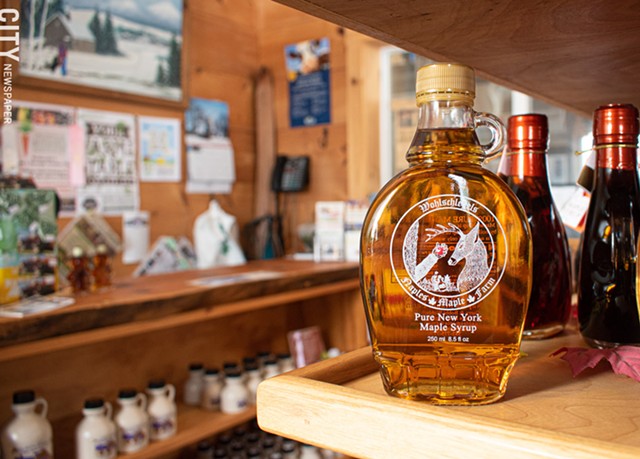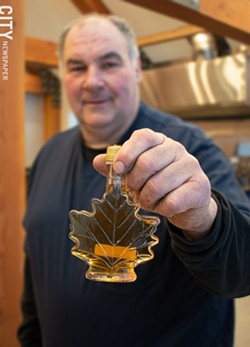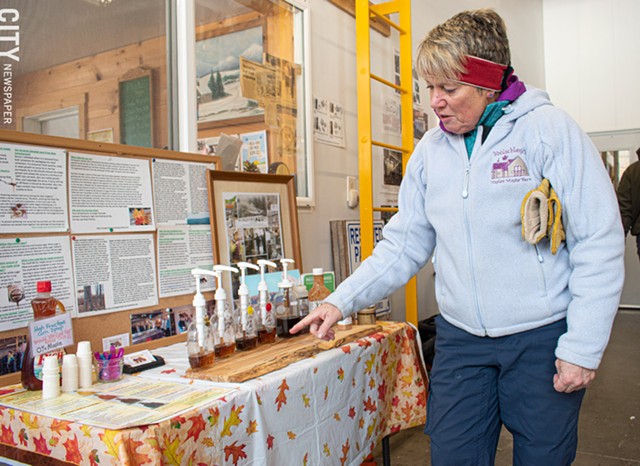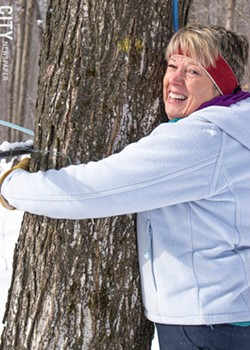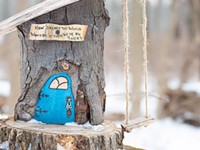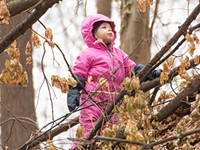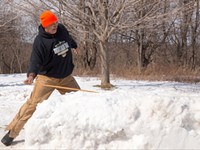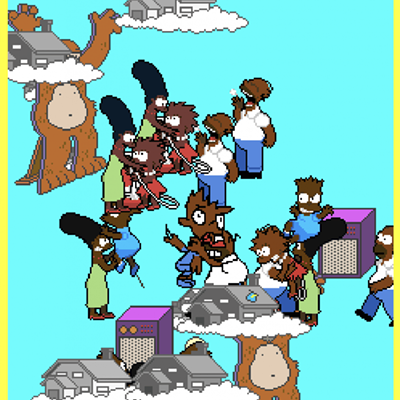[
{
"name": "500x250 Ad",
"insertPoint": "5",
"component": "15667920",
"parentWrapperClass": "",
"requiredCountToDisplay": "1"
}
]
Ever since I was a youngster, I've had an awful allergy to tree pollen. To get revenge on these giant bullies, I spent my 20s learning fine woodworking. I don't usually have a sweet tooth, but when CITY asked me to write about the local maple syrup industry, I thought, "What could be better on pancakes than the blood of my sworn enemies, the trees?"
I'm joking, of course. Trees are all right. The hardwood forests of the northeast are a unique and beautiful natural resource. Forests also sequester 10 to 15 percent of the nation's carbon emissions. And tree roots keep the topsoil in place; without them we'd experience more flooding from storm water runoff. Maple is the dominant species in New York forests, and has increased in prevalence over time as elm, chestnut, and ash populations fell to pests and disease. This has all set the stage for a big increase in maple syrup production in New York, now up 50 percent from five years ago.
The Empire State's maple syrup production is now ranked second in the country, cooking up a fifth of the nation's syrup. Sitting atop the proverbial flapjack stack is Vermont, which would count toward our total if they hadn't broken things off with New York and moved out in 1777. I'm not bitter about it or anything.
The process of making syrup is familiar for most upstate residents: trek out to the sugar bush, drill a hole in a tree, stick a tube (called a spile) in the hole, collect the sap in a bucket, and boil the sap until it's syrup. "Simple," I thought.
I was, of course, wrong. Maple cultivation is an intricate blend of modern tech, traditional practices, and luck.
I spoke with Garry Wohlschlegel, proprietor of Wohlschlegel's Naples Maple Farm, to learn about the technical side of the trade. Since a 2010 expansion, the family farm has been operating 4,100 taps on 40 acres of maple-dominated forest. It would be a tremendous undertaking to manually empty a bucket on every single tap each day. Instead, the Naples operation has connected 24 miles of tubing from their trees to a vacuum pump, which draws all of the harvested sap to a central location.
Once all of that sap is in one place, the next job is to get the water out. The traditional method is to boil the sap down, fragrantly reducing the liquid into thick syrup. Wohlschlegel, a former Kodak engineer, instead employs a process called reverse osmosis. "We're basically pushing water molecules and sugar molecules away from each other, using a semi-porous membrane," he explains. This process is very efficient, reducing the amount of fuel needed to process a gallon of syrup by a factor of four to six.
It can be hard to picture just how much water needs to come out before the syrup is ready. Dan Milke of Shadow Hill Maple Syrup in Ontario, New York, explains that part of the process is timing. "If you harvest early and your sugar content is low, you might need to start with 80 gallons of sap to get a gallon of syrup. If you wait later in the season, you might start with two or three percent sugar instead of one or one-and-a-half."
This brings up the luck aspect of the syrup trade. Both producers I spoke with emphasized that Mother Nature is in charge of the timing and supply. Maple trees only "run" when the temperature conditions are right, meaning a stretch of nights where the temperature is below freezing with days well above. The western New York region has had a few good years now. Milke says the season can be as short as a week or as long as a month, but that supply isn't threatened by a bad year.
"There's always more people getting into the business, and if we have a short season here there might be a longer one up north in the Adirondacks, so it balances out," he says.
Demand for maple products is growing faster than supply, as health-conscious consumers look for alternatives to processed sugar. Maple syrup contains a number of vitamins, minerals, and antioxidants, and its glycemic index is lower than sugar or molasses. Nutritionists recommend limiting all types of sugar intake, but the perceived benefits of alternatives like maple, honey, and agave have made a big difference in the marketplace.
Maple syrup production in New York state is decentralized, with more than 2,000 active operations. The combined output from these producers was 820,000 gallons in 2019. This is a challenging quantity of syrup to imagine. For perspective, Boston experienced history's stickiest industrial disaster in 1919, when a molasses tank burst and flooded the city. A highly scientific calculation tells me that New York's aggregate maple production is about one third of the amount required to flood Boston, though I suspect any attempt to do so would exacerbate regional rivalries beyond the perennial Yankees-Sox feud.
The Maple News reported that last season's average syrup price was $33.80 per gallon. This means the state's economic output from maple syrup was around $27 million on paper. This number is higher in reality, as farmers often boost the bottom line with value-added maple products like candy, barbecue sauce, and even dog biscuits.
With the recent warm weather, some sugar shacks are already fired up for syrup production. Many offer opportunities to visit their facilities from January through March, and this makes a great winter outing for families. Check out nysmaple.com, which has an interactive map to find a local maple producer near you. As these businesses tend to be small and seasonal, it's a good idea to call ahead to confirm daily hours and tour availability before you arrive.
Declan Ryan is a freelance writer for CITY. Feedback on this article can be directed to [email protected].
In This Guide...
Latest in Winter Guide
More by Declan Ryan
-
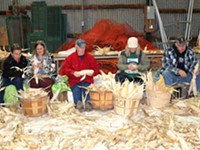
An ancient grain gets a regional revival
Sep 23, 2020 -

Quarantined: COVID-19 moves musicians to think outside the box
Mar 24, 2020 -
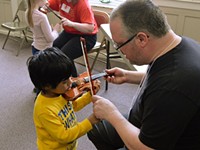
FAMILY | Musical Mystery Tour
Mar 4, 2020 - More »
